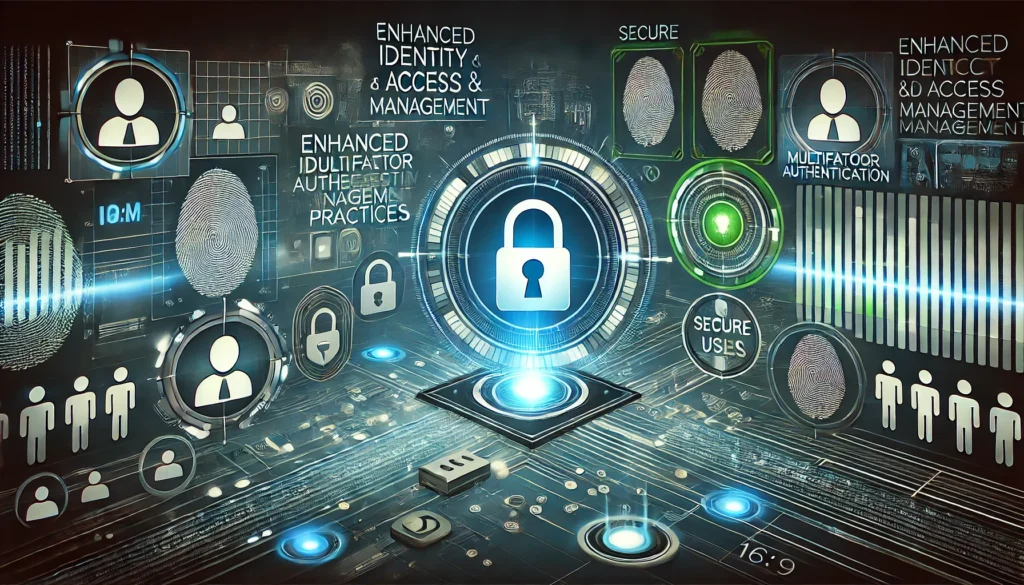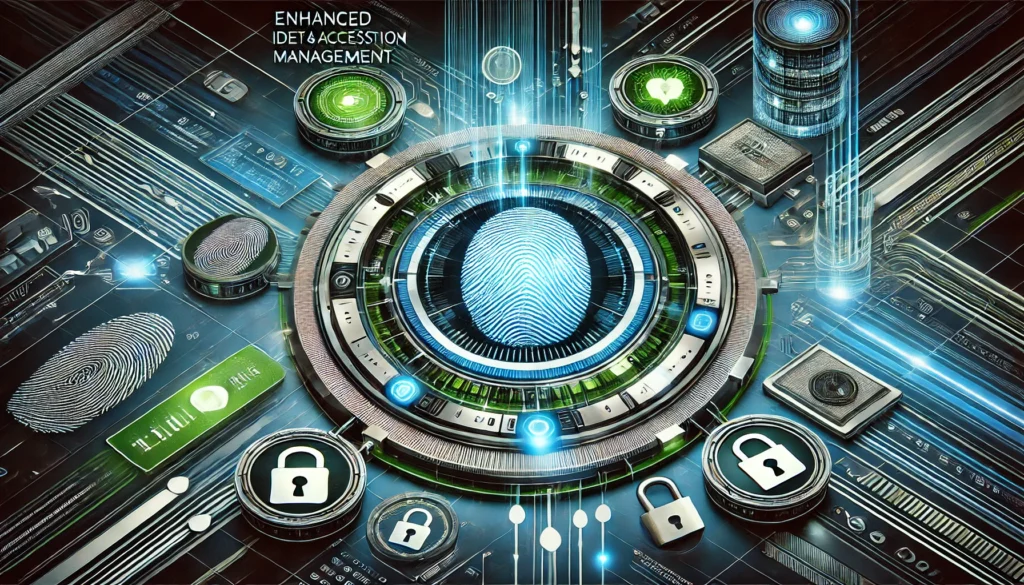Introduction
In today’s cybersecurity landscape, Enhanced IAM Security Practices are essential for safeguarding sensitive data and managing access effectively.

Why IAM is Essential in Cybersecurity
Identity and Access Management (IAM) is more than just a security tool; it’s the first line of defense. IAM solutions manage who has access to what information, ensuring that only authorized users can interact with sensitive data. In an era of distributed workforces and extensive cloud adoption, IAM plays a vital role in preventing unauthorized access. Traditional IAM systems are no longer enough. Enhanced IAM practices offer a more comprehensive solution, with features like multifactor authentication, role-based access, and continuous access monitoring.
Key Components of Enhanced IAM
1. Multifactor Authentication (MFA)
One of the most effective methods to secure identity is multifactor authentication (MFA). MFA requires users to verify their identity through multiple channels, such as passwords, biometrics, or one-time passcodes. Even if a malicious actor gains access to one factor (like a password), the additional verification steps reduce the likelihood of unauthorized access.
MFA’s popularity is rising because it significantly enhances security without adding excessive complexity for users. By implementing MFA, organizations reduce the risks associated with password-based authentication alone.
2. Adaptive Access Policies
Adaptive access policies are an innovative feature of modern IAM. They assess real-time factors—such as location, device type, and user behavior—before granting access. For example, if a user logs in from an unusual location, the IAM system might trigger additional authentication steps or deny access altogether.
By evaluating context-specific conditions, adaptive policies provide a flexible, secure approach to IAM. This proactive security measure not only minimizes risks but also offers a seamless experience for legitimate users.
3. Role-Based Access Control (RBAC)
Role-Based Access Control (RBAC) ensures that users have access only to the resources necessary for their job functions. By assigning permissions based on roles, RBAC limits the potential for accidental or malicious access to sensitive data. For instance, a financial analyst in an organization might access financial records, while a marketing team member wouldn’t need that same access.
RBAC simplifies access management, especially in large organizations, by streamlining permissions and reducing the potential for access abuse. This minimizes the risk of internal threats and keeps critical information secure.
4. Privileged Access Management (PAM)
For users with administrative or high-level privileges, Privileged Access Management (PAM) is essential. PAM ensures that privileged accounts are protected with additional security layers, monitoring, and strict access controls. This helps prevent misuse by limiting access to high-impact systems and applications.
With PAM, organizations can monitor, control, and audit all activities performed by privileged accounts, reducing the risk of insider threats and protecting sensitive infrastructure.
Advanced IAM Practices for Modern Security Needs
Continuous Monitoring and Analytics
Today’s IAM systems are more advanced, with capabilities for continuous monitoring and analytics. IAM platforms now leverage machine learning and AI to detect anomalies in user behavior. For example, if a user who typically accesses files during work hours suddenly logs in at midnight, the IAM system can flag this as suspicious.
Continuous monitoring allows organizations to spot irregularities in real-time, enhancing the speed and accuracy of threat detection.
Identity Lifecycle Management
Managing the entire lifecycle of an identity is critical to effective IAM. Identity Lifecycle Management (ILM) involves onboarding, modifying, and offboarding users, with appropriate access permissions for each phase. This is especially vital for contractors or temporary employees who may only need access for a limited period. By managing the lifecycle, organizations can ensure that access is granted only when necessary and revoked immediately when no longer needed.
Biometric Authentication
Biometric authentication is becoming increasingly common in IAM systems. With biometrics, users verify their identity using unique physical characteristics like fingerprints, facial recognition, or voice patterns. This approach provides an extra layer of security, making unauthorized access much more difficult.
Biometric authentication is particularly useful for sensitive areas of an organization, such as data centers or secure labs. However, it’s important to consider privacy concerns and ensure that biometric data is stored securely.

Best Practices for Implementing Enhanced IAM
1. Regularly Update Security Policies
Security policies are the foundation of IAM, but they must be kept up-to-date. By conducting regular reviews, organizations can ensure that policies align with evolving threats and organizational changes. For example, as remote work grows, policies should reflect new access requirements and risks associated with off-site access.
2. Educate Users on Security Practices
Users are often the weakest link in cybersecurity. Educating employees on best practices, including password management, recognizing phishing attempts, and securely handling sensitive data, is essential. The more informed users are, the less likely they are to inadvertently compromise IAM security.
3. Integrate IAM with Other Security Tools
IAM works best when integrated with other cybersecurity tools. Integration allows seamless communication between IAM and other tools, such as Security Information and Event Management (SIEM) systems, to enhance threat detection and response. This unified approach helps organizations respond swiftly to potential threats.
4. Regular Audits and Compliance Checks
Audits and compliance checks are vital for maintaining a secure IAM infrastructure. By regularly auditing access permissions, organizations can identify and correct potential vulnerabilities, ensuring compliance with regulations like GDPR, HIPAA, or CCPA. Compliance not only protects sensitive data but also builds trust with customers and partners.
Challenges in Implementing Enhanced IAM
While enhanced IAM practices strengthen security, they also bring challenges. Here are a few common obstacles:
- Complex Integration: Integrating IAM with legacy systems can be complex, requiring careful planning and execution.
- User Experience: Striking a balance between security and user experience is essential. Excessive authentication steps can frustrate users.
- Cost and Resources: Enhanced IAM requires investment in technology and human resources, which may be challenging for smaller organizations.
Organizations must address these challenges to maximize the benefits of IAM. Engaging experienced cybersecurity professionals and leveraging IAM vendors can help mitigate these issues.
Future Trends in IAM
As technology advances, IAM will continue to evolve. Some trends to watch include:
- Zero Trust Architecture: IAM will play a critical role in the Zero Trust model, where every user and device is continuously verified before gaining access.
- Decentralized Identity: Decentralized Identity enables users to control their identity through blockchain-based verification, offering more privacy and security.
- AI-Driven Automation: Machine learning and AI will drive automation in IAM, predicting user behaviors and adjusting access based on real-time insights.
By staying aware of these trends, organizations can prepare to adapt their IAM practices, staying ahead of potential security threats.
Conclusion
Enhanced Identity and Access Management is indispensable in today’s digital environment. With the rise of remote work and complex cyber threats, IAM has become the foundation of a secure enterprise. Practices like multifactor authentication, adaptive policies, and privileged access management offer robust protection, while continuous monitoring ensures that security threats are detected early.
For organizations aiming to strengthen their security posture, adopting enhanced IAM practices is a strategic investment. With the right approach, IAM can safeguard data, build trust, and create a more resilient cybersecurity framework.
Follow my website for more interesting and insightful blogs!
